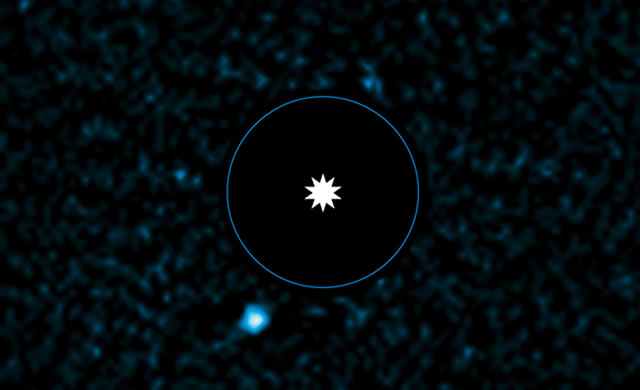
Un’equipe di astronomi ha fotografato con il VLT (Very Large Telescope) dell’ESO un oggetto debole in movimento vicino a una stella brillante. Con una massa stimata di circa quattro o cinque volte quella di Giove, sarebbe il pianeta più leggero osservato direttamente al di fuori del Sistema Solare. La scoperta è un contributo importante alla nostra comprensione della formazione ed evoluzione dei sistemi planetari.
Anche se sono già stati individuati indirettamente quasi mille esopianeti – la maggior parte di questi con metodi come la velocità radiale o il transito – e molti altri candidati attendono una conferma, solo una dozzina di esopianeti sono stati fotografati direttamente. Nove anni dopo che il VLT (Very Large Telescope) dell’ESO ha catturato la prima immagine di un esopianeta, il compagno planetario della nana bruna 2M1207 (eso0428), la stessa squadra ha ritratto quello che è probabilmente il più leggero di questi oggetti finora trovato. “Ottenere direttamente l’immagine di un pianeta è una tecnica molto impegnativa che richiede gli strumenti più avanzati, sia da terra che dallo spazio,” spiega Julien Rameau (Institut de Planetologie et d’Astrophysique de Grenoble, Francia), primo autore dell’articolo che annuncia la scoperta. “Solo pochi pianeti sono stati osservati direttamente finora, rendendo ogni singola scoperta una tappa fondamentale sulla strada della comprensione dei pianeti giganti e della loro formazione”. In queste nuove osservazioni il probabile pianeta si mostra come un puntino debole ma ben definito vicino alla stella HD 95086. Un’osservazione successiva mostra anche che si muove lentamente con la stella in cielo. Questo suggerisce che l’oggetto, che è stato designato HD 95086 b, sia in orbita intorno alla stella. La sua luminosità indica anche la massa prevista sia all’incirca solo quattro o cinque volte quella di Giove.
Fonte/Leggi tutto → ESO.org
A team of astronomers using ESO’s Very Large Telescope has imaged a faint object moving near a bright star. With an estimated mass of four to five times that of Jupiter, it would be the least massive planet to be directly observed outside the Solar System. The discovery is an important contribution to our understanding of the formation and evolution of planetary systems.
Although nearly a thousand exoplanets have been detected indirectly — most using the radial velocity or transit methods — and many more candidates await confirmation, only a dozen exoplanets have been directly imaged. Nine years after ESO’s Very Large Telescope captured the first image of an exoplanet, the planetary companion to the brown dwarf 2M1207 (eso0428), the same team has caught on camera what is probably the lightest of these objects so far. “Direct imaging of planets is an extremely challenging technique that requires the most advanced instruments, whether ground-based or in space,” says Julien Rameau (Institut de Planetologie et d’Astrophysique de Grenoble, France), first author of the paper announcing the discovery. “Only a few planets have been directly observed so far, making every single discovery an important milestone on the road to understanding giant planets and how they form.” In the new observations, the likely planet appears as a faint but clear dot close to the star HD 95086. A later observation also showed that it was slowly moving along with the star across the sky. This suggests that the object, which has been designated HD 95086 b, is in orbit around the star. Its brightness also indicates that it has a predicted mass of only four to five times that of Jupiter.
Source/Continue reading → ESO.org





















